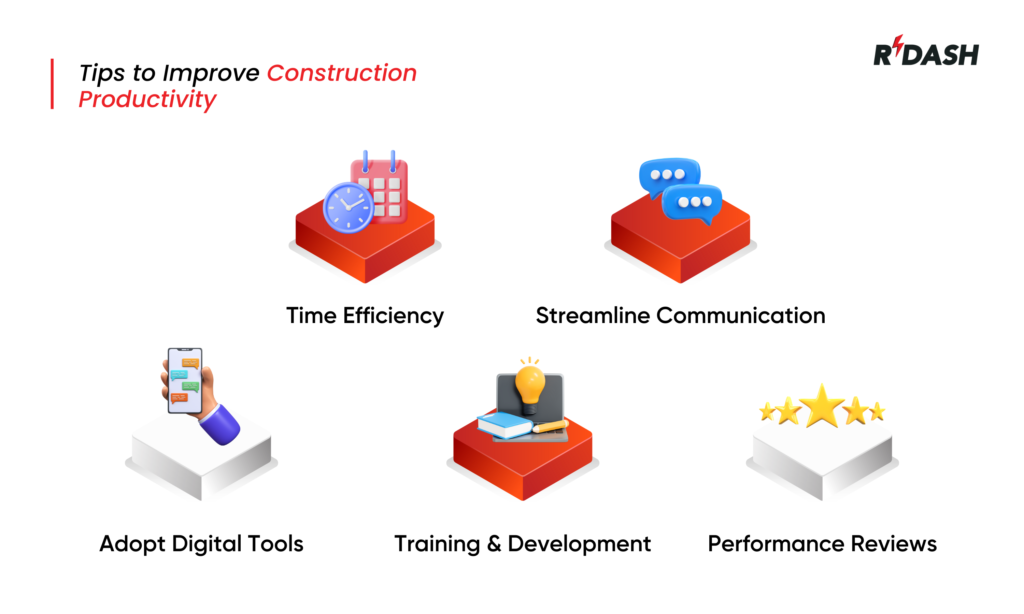What is construction productivity?
Productivity in the construction industry measures how effectively an organization utilizes labor, materials, and equipment to complete projects like buildings and roads. The significance of productivity lies in its ability to determine the speed and cost-effectiveness of project delivery, which in turn influences the potential to maximize firm profits. Construction companies keep a close eye on their progress and check how much work they can get done in a certain amount of time to improve productivity. They often invest in tools to help track this progress and develop methods to do more work faster, which helps them make more money.
How to measure construction productivity
Measuring construction productivity encompasses a number of key indicators. Some of the most commonly used metrics include:
Labor Productivity: This is usually measured by output per labor hour, and it can be calculated by dividing total work done (units completed) by the total number of labor hours worked.
Material Productivity: This shows how well materials are used by comparing the amount used to the total amount given for the project.
Capital Productivity: It has to do with the determination of the return on investment for equipment and technology put into a construction project.
The choice of metrics depends mostly on the scope of the project, the detail of the tasks involved, and the critical resources for the project.
Factors affecting construction productivity
Many things can really affect how well a construction project goes. Here are four crucial ones:

Pay structure
Compensation is an immediate motivator of an employee’s performance. Competitive pay structures, coupled with bonus and other incentive systems, can also stimulate productivity when employees become more motivated to work hard and aim at the desired goals for the project.
Workplace Wellbeing
The physical and psychological conditions of the workplace can significantly impact workers’ productivity. Supportive and healthy work environments are linked to increased morale and efficiency. Harmful conditions increase the chances of injuries and illnesses, lower morale, and consequently adverse productivity. Implementing wellness programs and standards of safety enhance the productivity workforce.
Lack of Tools and Technologies
The use of advanced tools and technologies in the modern construction world is very important for maximizing output. The absence of such resources within a team limits its efficiency in performing tasks. Investment in the right technologies, including management software, sophisticated machinery, and automation tools, can definitely boost productivity as processes would be streamlined, and this will reduce the amount of manual labor required.
Workforce Diversity
Diverse teams bring together more perspectives and skills, which can lead to an innovative solution and more sophisticated problem-solving in complex projects. In addition, an inclusive place of work where every person feels valued is likely to attain higher job satisfaction and productivity.
Productivity in the construction sector is a critical measure that may often point to significant inefficiencies directly impacting projects’ timelines, budgets, and success. Many factors challenge the maintenance of high productivity, ranging from outdated practices to inadequate project management. These challenges can lead to costly delays and decreased profitability. It becomes essential to understand the roots of these productivity issues in developing effective solutions.
Key issues impacting construction productivity
Lack of Digital Tool Adoption
A major hurdle in contemporary construction is the underutilization or outright avoidance of digital tools. As industries worldwide have moved towards digital solutions, construction has often lagged, relying instead on manual processes that are both time-consuming and error-prone. The absence of technologies like construction management software, digital blueprints, and real-time project tracking systems can significantly hinder a project’s efficiency and accuracy.
Poor Communication
Good communication is a vital factor in any successful construction project. The industry often suffers from poor communication channels, causing frequent misunderstandings, mistakes, and rework. When numerous teams and people have to collaborate on large and complex projects, bad communication can drag things down quite a lot.
Poor Time Management
Construction time management involves the coordination of various tasks with precision to avoid downtime and ensure continuous progress. Common inefficiencies include poor planning, delays in material delivery, and mismanagement of the workforce, all of which result in significant time wastage and project delays.
Tips to improve construction productivity
Construction firms can use the following strategic approaches to address these pervasive issues:

Adopt Digital Tools: The adoption of cutting-edge digital tools can significantly enhance the accuracy and efficiency of construction projects. Some of the technologies that may include Building Information Modeling (BIM), automated scheduling systems, and project management software like RDash will provide comprehensive oversight, real-time updates, and ensure all team members are consistently aligned with the project goals.
Time Efficiency: Effective project planning and scheduling is key. Digital tools for creating detailed project timelines help visualize the entire lifecycle of the project and respond to changes dynamically. On-time delivery of materials and optimal use of labor resources can avoid most common delays.
Training and Development: The investment in training for the workers can lead to long-term productivity gains. The better trained and more knowledgeable workforce will be about the latest construction techniques and tools, and this will increase efficiency and result in a higher quality output.
Streamline Communication: Developing strong communication protocols is vital. Utilizing collaborative platforms that facilitate easy sharing of information and updates can transform the project dynamics. Holding regular meetings and using mobile technology for instant updates can help keep everyone involved informed and ready to tackle project needs.
Regular Performance Reviews: Establish a system of regular performance evaluation to identify areas where productivity lags. This feedback loop is a continuous process for improvement and keeps all team members accountable for their part in the project’s success.
Improving construction productivity is an indispensable factor for the effective and timely completion of projects without incurring a loss. Using appropriate technological solutions, enhancing powerful communication, effective time management, and continuous training for personnel can help construction companies effectively overcome the common factors of low productivity. These are changes that improve the smooth operation process and greatly enhance the successful achievement of profitability in construction works.






